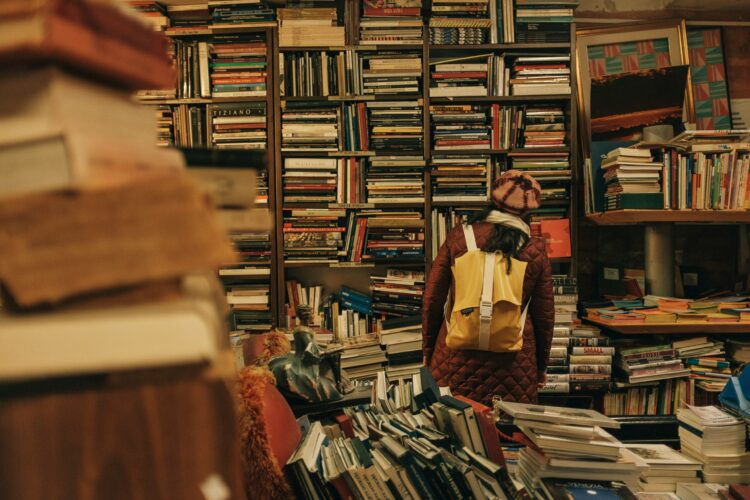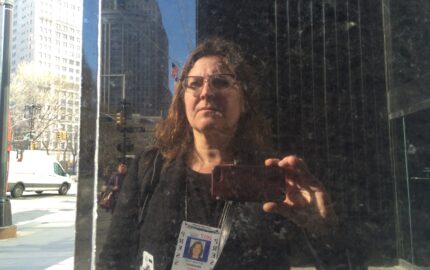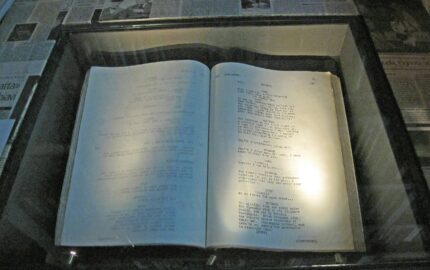Back in March, The New York Times published a how-to piece on styling bookshelves. It was written by Tim McKeough and featured Jeremiah Brent, who is on the cast of the Netflix series “Queer Eye.” (Brent must also an influencer because the story mentioned his popular Instagram account.) Anyway, in the story, Brent went into great and often useful detail about how he and his husband arrange the shelves in their Manhattan apartment. There’s even a video, played in speed-up mode, of Brent doing one of those arrangements. This arranging apparently happens frequently, as the couple travels, shops, exchanges gifts and shows off new art from their two children. Their bookshelves evolve with their lives. Brent says the goal is to provide “an opportunity for people to look in and see where you’ve been and where you’re going.”
I’ve never thought of “styling” my bookshelves. I’m challenged enough trying to find space on them for, well, books. The Times piece gives a nod to my approach, which it refers to as “stuffing.” That’s fine, I read, for a home library, as if the piece assumed we all have a home library. But for a more artful effect, Brent urges people to think of the shelves not so much as storage for, well, books, but as art display cases. That means being selective about which books are included on the shelves, and prioritizing books with “good-looking covers.” According to the story:
Well-worn paperbacks and other less attractive books can be stored elsewhere.
I was really trying to hang in with Brent. I love books and well-curated displays and lack of clutter.
But some of my most attractive books — at least to me — are also the most worn. They are the ones I want within reach of whatever chair I happen to plop into, the ones I thumb through again and again as I look for a passage I want to re-read, the ones I grab when I’m writing or outlining a workshop for other writers. They are the too-many books I am reading now and the too-many more I bought with the faith I would read them someday. They are those I loved so much that I vowed to re-read them — and will, just as soon as I get through all the wondrous new books that come my way.
More to the story than that between the covers
One of my favorite books is one I’ve never read and never will. The black linen cover is faded to gray, and so tattered that the back spine has peeled off entirely; only the stitching holds it together. The print is tiny. A blank back page is marred with scribbles of red ink where someone must have been trying to get a ballpoint started.
The book came to me some 35 years ago. I was living in Minneapolis. Minnesota, working as a reporter in neighboring St. Paul. My parents called to say they were making the five-hour drive across Wisconsin to bring me something. This was an event so rare as to be unsettling. We weren’t always on the best of terms; my passion for journalism was not always comfortable for them. It involved a whole lot of what my mother called “gallivanting” and was way too nosy for people whose prime directive was Mind Your Own Business.
I can’t remember if they were hauling a trailer when they pulled up or had fit things into the back of my father’s truck. But soon we were hauling a collection of heavy boards and a box of hardware up the multiple sets of stairs that led to my house. Then we got to work. No preamble, no time for chit-chat, they weren’t staying long.
In the next few hours, my mother and I cleared out a part of the small room where I kept my sewing machine and my first computer. My father grumped and huffed a bit: I didn’t have a proper work space; I didn’t have the right tools; I had books stacked on floors, which he found unsightly; the floors and walls in my old Craftsman house were off of true. All the while he was at work, putting in bolts and nuts, placing brackets, using a level to ensure things were as even as he could make them.
And then I had a new set of bookshelves! Actually, they were old shelves: heavy white oak that had been lacquered multiple times over the years. My parents had bought them at an estate sale after the vocational high school — really a Catholic seminary for prospective priests — in my home village closed. These shelves had stood for countless years in the seminary library library, hunted through by hundreds of young seekers. Now they were mine, as was the imagining of all they had held before.
As my parents were climbing back into the truck for the drive home that same day, my father made it clear that I needed to get my mess of books off the floors and onto those shelves. Then my mother quietly handed me a small package, telling me it was a gift for my new shelves.
They left. I went back inside to clean up the construction mess and ponder the chore of reorganizing my books. But first I opened the package from my mother.
Stories between the pages
It was that faded black book, tattered with decades of use. There were scrolls embossed on the cover, but no title. It was small and fit perfectly in my hand. I opened it to find a Mass hymnal. Or I think that’s what it was. The hymns were in Polish, the Mass passages in Latin, which I recognized from my childhood in church. The blank opening page held the stamp of the “St. Joseph Vocational School for FRANCISCAN FATHERS, Assumption Monastery, Pulaski, Wis.” The signatures of two brothers who lived at the monastery were scrawled by hand. And there was a yellow Post-it note in my mother’s handwriting:
Explanation via separate mail. Note printing date. Ma
It took me awhile to hunt through the Polish to find that date, but there it was: 12 Octobris 1901
My mother wasn’t Polish or Catholic; she had plenty of issues with the Catholic church in which she had to raise her five children. She cleaned and cooked and sewed and knitted to hold the house together. She also was a voracious reader, but we had little money or room to buy and store books beyond a fat dictionary and a set of encyclopedias bought with coupons; instead, she frequented the biweekly bookmobile that served as a library in my village and brought me along as soon as I had cracked the code of letters and sentences. My father was a WWII veteran who worked hard-and-rough with his hands to support those children; he could still speak Polish with the old people in the village and occasionally lapsed into the lilt of that language. His reading was largely limited to the daily newspaper and to stacks and stacks of Popular Mechanics and carpentry magazines. Neither had the chance for an education past high school. Both insisted we make our own schooling a priority and earned college degrees, and that we pay our own way through.
My brothers all became engineers who landed solid jobs and built solid stuff. Theirs were worlds my parents understood.
Me? I went into journalism, moved to a new newsroom every two or three years, traveled the world, poked into people’s lives, challenged authority and wrote stories. To them, my world no doubt seemed insubstantial and flitting. And it was so damn nosy.
The blessing of books
But now, 15 years into my amorphous career, I felt they had blessed my decision. My mother slipped me a book, understanding that it didn’t matter if I could actually read it. I would hold it in my hand, add my own thumb to the well-thumbed pages and wonder at all the stories it held.
As for my father, he brought me the solidity of bookshelves. He found a sturdy, mostly level place for me to hold the words and stories and learning I so treasured while I honored his treasure of an ordered house.
Maybe he also recognized that I, too, was a builder — one who worked not with wood and metal and the tools of a carpenter, but with words and ideas and the tools of a storyteller.
I no longer have those bookshelves. They were passed along some years ago, during another move, to someone who coveted them. But I still have the worn old Mass hymnal. And with all respect to Brent and his artful arrangement of books with their perfect covers, I can’t imagine hiding it in a storage closet. The story it tells is too beautiful to be hidden.
* * *
Postscript: A version of this essay was first published as a Storyboard newsletter on May 3, 2024. A reader sent a note saying I had failed to complete the story by not circling back to the information in the follow-up letter my mother had promised. The short version: She said a gift of bookshelves should come with the gift of a book. This was on the shelves they bought for me. She paid 25 cents.



